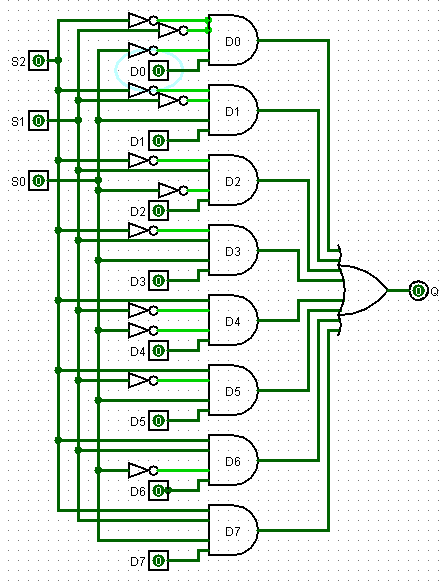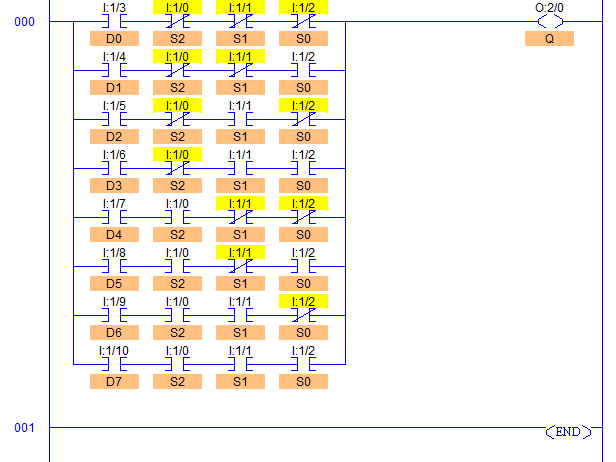This is a PLC Program to Implement 8:1 Multiplexer.
Problem Description
Implementing 8:1 Multiplexer in PLC using Ladder Diagram programming language.
Problem Solution
- There are m-data inputs, one output and n select lines, with 2m = n.
- To select n inputs, we need m select lines such that 2m = n.
- Depending on the output. The selection of one of the n inputs is done by the select pins.
- It does not need K-map and simplification so one step is eliminated to create Ladder Logic Diagram.
- Realize the multiplexer using Logic Gates.
- Truth Table can be written as given below.
Data Select Inputs Output Inputs S2 S1 S0 Q D0 0 0 0 D0 D1 0 0 1 D1 D2 0 1 0 D2 D3 0 1 1 D3 D4 1 0 0 D4 D5 1 0 1 D5 D6 1 1 0 D6 D7 1 1 1 D7
Realizing 8:1 Mux using Logic Gates

PLC Program
Here is PLC program to Implement 8:1 Multiplexer, along with program explanation and run time test cases.
List of Inputs and Outputs S2= I:1/0 (Select Line Input) S1= I:1/1 (Select Line Input) S0= I:1/2 (Select Line Input) D0= I:1/3 (Data Line Input) D1= I:1/4 (Data Line Input) D2= I:1/5 (Data Line Input) D3= I:1/6 (Data Line Input) D4= I:1/7 (Data Line Input) D5= I:1/8 (Data Line Input) D6= I:1/9 (Data Line Input) D7= I:1/10 (Data Line Input) Q= O:2/0 (Output)
Ladder Diagram to obtain output

advertisement
advertisement
Program Description
- In all the rungs, S2 (I:1/0), S1 (I:1/1) and S0 (I:1/2) are used as a selector line input as shown in Logic Circuit.
- D0 to D7, I:1/3 to I:1/10 are Data Inputs respectively.
- When S2 (I:1/0), S1 (I:1/1) and S0 (I:1/2) are low, output will have whatever state D0 I:1/3 holds, either 1 or 0.
- When S2 (I:1/0) and S1 (I:1/1) are low and S0 (I:1/1) is high, output will have whatever state D1 I:1/4 holds.
- Similarly remaining six different inputs are performed.
- In other words, according to bit pattern of S2, S1 and S0, Data bits from D0 to D7 are passed to output.
- Here, instead of bits D0 to D7, any functions such as moving, jumping or moving can be performed as well depending upon the application.
Runtime Test Cases
Data Select Inputs Output Inputs S2(I:1/0) S1(I:1/1) S0(I:1/2) Q(O:2/0) D0 (I:1/3) 0 0 0 D0 0 or 1 D1 (I:1/4) 0 0 1 D1 0 or 1 D2 (I:1/5) 0 1 0 D2 0 or 1 D3 (I:1/6) 0 1 1 D3 0 or 1 D4 (I:1/7) 1 0 0 D4 0 or 1 D5 (I:1/8) 1 0 1 D5 0 or 1 D6 (I:1/9) 1 1 0 D6 0 or 1 D7 (I:1/10) 1 1 1 D7 0 or 1
Sanfoundry Global Education & Learning Series – PLC Algorithms.
To practice all PLC programs, here is complete set of 100+ PLC Problems and Solutions.
